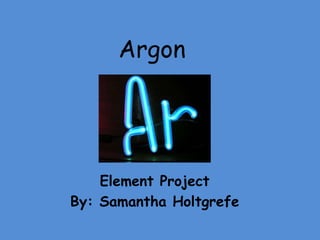
Properties and Uses of the Noble Gas Argon
- 1. Argon Element Project By: Samantha Holtgrefe
- 2. Properties of Argon Noble Gas ( most Noble Gas on Earth) Element # 18 Melting Point : -189.35 degrees Celsius Boiling Point: -185.85 degrees Celsius Gas at room temperature, colorless Found in small amounts of air, and Earths atmosphere Density: 1.784 g/L Argon costs between $2.80 to $4.80 per liter.
- 3. Uses of Argon • Fills light bulbs to protect the filament • Forms inert atmosphere that is good for many forms of welding • Extinguishes fires without damaging equipment • Used in museums to protect and preserve old documents and materials • Argon lasers are used in surgery to weld arteries, destroy tumors, or correct eye defects. • Used in fluorescent tubes, usually emits a blue light
- 4. Argon was discovered in 1894 by Sir William Ramsay a Scottish chemist (above), and Lord Rayleigh an English chemist. It was the first of the noble gases to be isolated. •Makes up 0.93% of the Earths atmosphere. •Argon is obtained from the air as a byproduct of the production of oxygen and nitrogen.
- 5. • Rayleigh and Ramsay discovered argon by the fractional distillation of liquid air. Fractional distillation is the process of letting liquid air slowly warm up. As the air warms, different elements change from a liquid back to a gas. The portion of air that changes back to a gas at - 185.86oC (-302.55oF ) is argon. • The symbol A was used for argon until the 1950s when chemists agreed to use the two letter symbol Ar for the element. • Argon is derived from the greek word inactive, argos. This is because it undergoes almost no chemical reaction
- 6. • Three isotopes of argon exist naturally. They are argon-36, argon-38, and argon-40 • Six radioactive isotopes of argon are known also.
- 7. Bibliography • http://www.atomic- elements.info/argon_data.html • http://education.jlab.org/itselemental/ ele018.html/ • http://www.chemicool.com/element/arg on.html